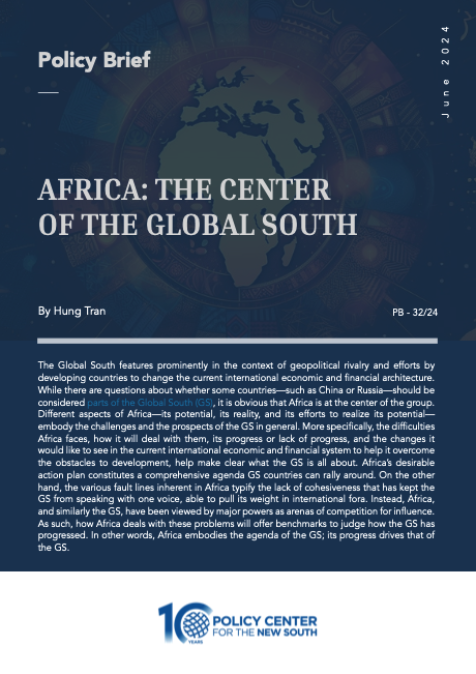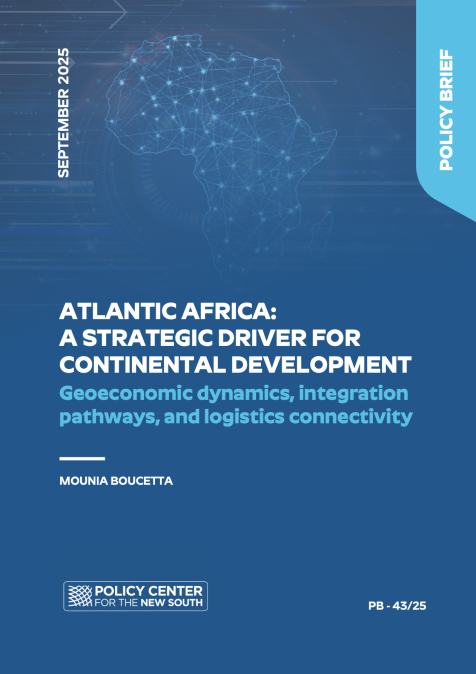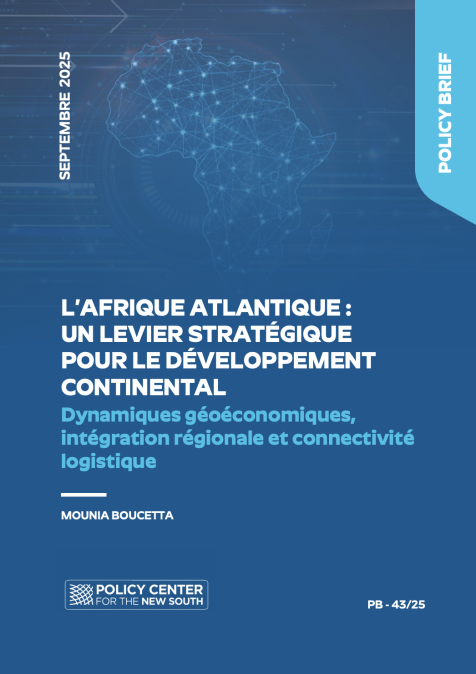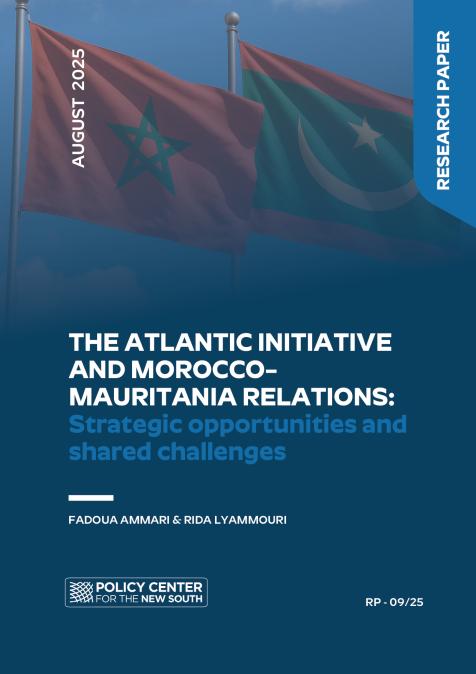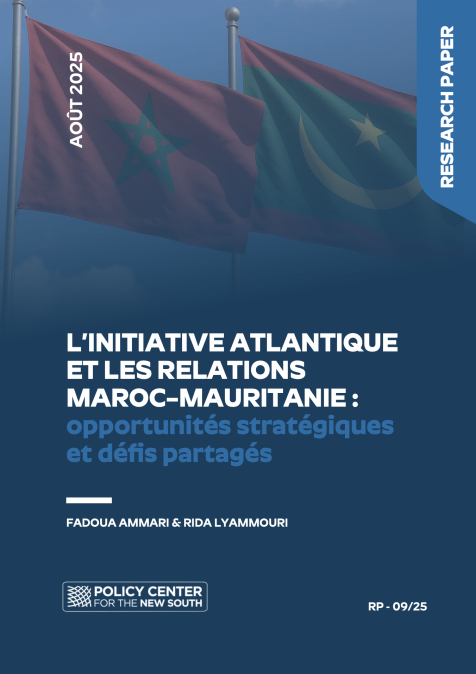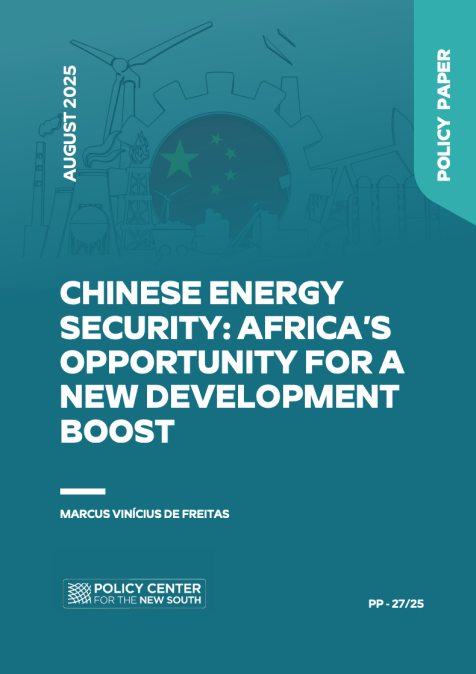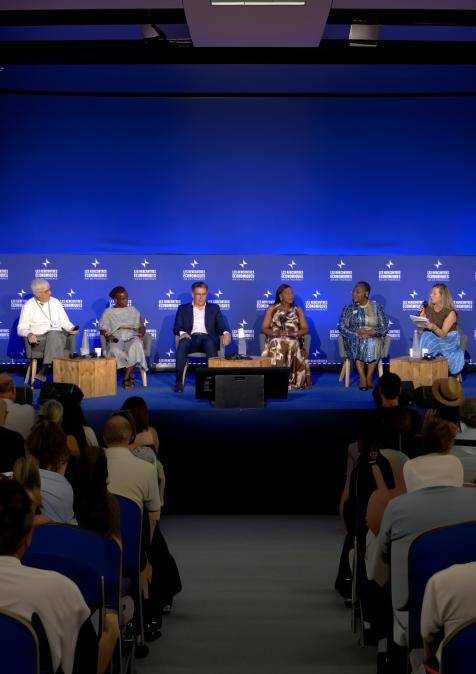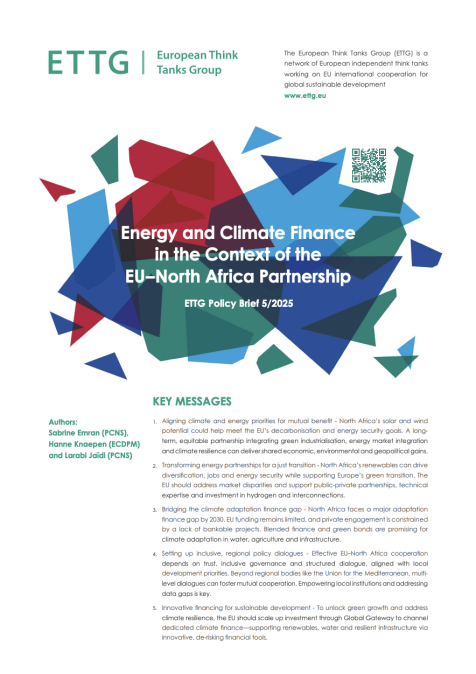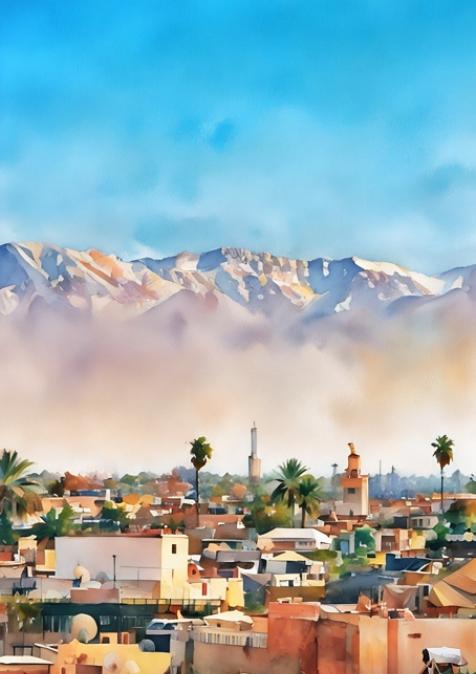Publications /
Policy Brief
The Global South features prominently in the context of geopolitical rivalry and efforts by developing countries to change the current international economic and financial architecture. While there are questions about whether some countries—such as China or Russia—should be considered parts of the Global South (GS), it is obvious that Africa is at the center of the group. Different aspects of Africa—its potential, its reality, and its efforts to realize its potential—embody the challenges and the prospects of the GS in general. More specifically, the difficulties Africa faces, how it will deal with them, its progress or lack of progress, and the changes it would like to see in the current international economic and financial system to help it overcome the obstacles to development, help make clear what the GS is all about. Africa’s desirable action plan constitutes a comprehensive agenda GS countries can rally around. On the other hand, the various fault lines inherent in Africa typify the lack of cohesiveness that has kept the GS from speaking with one voice, able to pull its weight in international fora. Instead, Africa, and similarly the GS, have been viewed by major powers as arenas of competition for influence. As such, how Africa deals with these problems will offer benchmarks to judge how the GS has progressed. In other words, Africa embodies the agenda of the GS; its progress drives that of the GS.
Africa’s Potential
In light of world demographic developments and heightened geopolitical tension, the potential of Africa has commanded much international attention. Africa has become the target of competition between major powers.
While most of the world’s population is going through a process of ageing, suffering from declining birth rates well below the replacement ratio of 2.1, Africa has a young population (two-thirds under thirty years of age) of 1.4 billion (or 18% of the world total), which is expected to almost double to 2.5 billion in 2050 (or 25% of the world total). Properly employed, Africa’s growing working-age population would fuel strong economic growth to compensate for slower growth in developed countries—thus being in a position to help them provide for their ageing populations.
Africa has a significant but not fully tapped agricultural sector—accounting for 65% of the earth’s uncultivated arable land. Agriculture employs 60% of Africa’s population (with most working as smallholder farmers) and contributes 23% to its GDP. According to McKinsey, with proper policies, investment, and farming techniques, Africa could produce annually two to three times more than its current volume of cereals and grains, raising global output (currently at 3.6 billion tons per year) by 20%—potentially a big step forward in addressing the world’s growing acute food-insecurity crisis.
Specifically, against the backdrop of geopolitical rivalry, competition among major powers for trade and investment relationships with African countries has become a strategic undertaking. Furthermore, the transition to green energy, which uses many times more critical minerals than fossil fuel, has intensified the race to secure access to those minerals. Africa is well endowed with natural resources: accounting for nearly 30% of the world’s mineral reserves including 90% of platinum, 56% of cobalt, 54% of manganese, 40% of gold reserves, 36% of chromium, 30% of rare earths, more than 20% of aluminum and copper, 12% of oil and 8% of natural gas, as well as large reserves of diamonds and uranium. Thus Africa has become the battlefield for major powers to compete for access to minerals. On the other hand, if properly managed, those mineral resources can attract substantial investment from all major powers, which can help support Africa’s economic development.
Africa also has tremendous potential for solar and wind power. According to the International Energy Agency (IEA), Africa has 60% of the best solar energy resources globally. Renewables including solar, wind, hydropower, and geothermal power could account for more than 80% of new power generation capacity by 2030. Properly structured and managed, with adequate storage facilities and transmission grids in place, Africa could supply clean electricity to itself and Europe. This potential should act as a magnet for investment from both sides of the geopolitical divide.
Last but not least, Africa is on or near important maritime trade routes, including the Gulf of Guinea, the Cape of Good Hope, the Red Sea, and the Suez Canal—a significant volume of world trade is shipped through these lanes annually. Disruption to shipping in the Red Sea or the Strait of Hormuz, for example, will have a significant impact on world trade, especially oil, depressing economic growth and pushing up prices. On the other hand, ready access to these maritime trade routes would greatly facilitate Africa’s trade with the rest of the world.
Africa’s Reality
Relative to its potential, the current African economic situation is disappointing, leading to discontent among its people, especially the young. Despite its relatively large share of the world’s population (18%), Africa contributes only 2.7% of global GDP and only 2% of world trade, having fallen from 4% in 1980. Its per-capita GDP is the lowest in the world—less than $2000 per year—compared to the global average of $13840, according to the World Bank. Despite its agricultural potential, Africa is in a severe food crisis.
From 2000-2010 Africa was able to grow by 5.1% p.a., but slowed to 3.3% p.a. in 2010-19. It has not fully recovered from the COVID-19 setback, having lost 2.4 percentage points of GDP relative to the pre-COVID-19 trend (as of 2023). Its income gap with the rest of the world has widened to its disadvantage.
More importantly, Africa has been able to create about 3 million formal wage jobs a year while 12 million young people will enter the labor force every year over the next decade. Consequently, Africa suffers from high unemployment among people aged 15-24—averaging more than 20%. In particular, South Africa has the highest youth unemployment rate in the world at 61%. Providing employment opportunities is therefore the top concern for young people in Africa. Against that backdrop, Africa needs to implement a growth strategy that not only creates substantial value added for the economy, but also provides significant numbers of new jobs annually. Without successful implementation of such an employment-focused growth strategy, the current situation will swell the ranks of the unemployed or under-employed youth, who are relatively educated, posing serious social and political risks for Africa—with spillovers onto the rest of the world, including in the form of migration, which could affect Europe in particular because of its geographical proximity. In that sense, what should be a demographic dividend fueling growth in Africa could turn into a social and political crisis with global ramifications.
Africa’s Transition Challenges
The fact that Africa has failed to realize its potential is the result of a combination of factors, ranging from the historical legacy of independent African states, a global economic and financial architecture not conducive to its development, and geopolitical rivalry adding to the headwinds facing Africa.
The historical legacy remains the heaviest burden on Africa. It includes the significant and long-lasting impact of the slave trade, the arbitrary delineation of national boundaries cutting across various ethnic and tribal groups, a colonial economic structure designed by the European colonizing countries to extract natural resources from Africa, and to use it as a market for manufactured products from the home countries, lack of a tradition of effective social and political institutions, especially for public governance, and reliance on primary commodities subject to worsening terms of trade and volatility of prices, as well as on foreign borrowing to make up for insufficient domestic savings. In particular, the colonial legacy and ethnic animosity have led to violent inter-state and domestic conflicts. These legacy problems have reinforced each other and hampered African countries’ development efforts since independence.
On top of these domestic problems, the international economic and financial system underpinned by the U.S. and Europe since the end of the Second World War has exacerbated Africa’s economic weaknesses. International trade and investment with Africa has tended to concentrate on the extraction of natural resources (instead of developing infrastructure and manufacturing) and debt financing—rather than equity financing such as foreign direct investment (FDI). Specifically, about three-quarters of Africa’s exports are primary commodities, in raw or unprocessed states, while most of its imports from outside the continent are manufactured consumer and capital goods. This has made Africa vulnerable to fluctuations in commodity prices and capital flows.
Africa has also experienced a notable decline in net external financial inflow (both official and private)—from 4% of GDP in 2010-19 to 2% in 2023–belying the repeated calls by international organizations and non-governmental organizations to mobilize financial support for Africa. Importantly, African countries have built up significant levels of public debt of 60% of GDP on average. Debt servicing accounts for almost 20% of their budgets, crowding out other necessary expenditures including education, healthcare, and infrastructure investment. Many African countries have experienced repeated debt crises requiring debt restructuring, followed by deep recessions. Over time, these setbacks have cumulatively and substantially reduced the average growth rate of African countries.
Africa has the world’s largest carbon sinks—its peatlands and forests—which could have been key to reducing global net greenhouse gas emissions. However, this carbon sink capacity has significantly diminished in recent years, because of increasing economic activity, especially farming, driven by population growth. This adds another dimension to the urgent need to promote sustainable development in Africa, with proper attention to climate-change mitigation and transition. A report by the UN Economic Commission for Africa (ECA), the African Union, the African Development Bank (AfFB), and UN Development Program ((UNDP) highlighted the fact that 60% of climate disasters worldwide were recorded in Africa, adversely impacting its peoples and economies. The report concluded that the current pace of progress is insufficient for Africa to achieve the UN Sustainable Development Goals by 2030.
Last but not least, geopolitical rivalry has fragmented the global economy, especially trade and investment flows. This has led to a reduction in foreign direct investment, hurting African countries the most—they now receive less FDI than remittances from Africans working abroad. Upheavals in commodities markets, such as the spike in oil and food prices following Russia’s invasion of Ukraine, have negatively impacted many sub-Saharan African countries.
In addition to these traditional problems, Africa may also face stiff competition from other major GS countries for international markets and FDI opportunities. Specifically, China’s successful development model—becoming the manufacturing workshop of the world and accounting for 40% of global manufacturing output—has led to overcapacity in many sectors, such as steel and green energy products. These developments—which have contributed to the growing use of protectionist measures in world trade—have significantly reduced the space for Africa to implement the same manufacturing strategy for its development. Similarly, countries like China, India, and the Philippines have captured significant global market shares in the export of services, especially in the IT sector, making it difficult for Africa to compete. As latecomers, African countries may be faced with a severely constrained opportunity set of development models and strategies.
Generally speaking, GS countries share many, though probably not all, of Africa’s domestic and international predicaments. Africa’s experiences therefore offer useful lessons to the GS.
Africa as an Arena for Geopolitical Competition for Economic Influence and Access to Critical Minerals
Africa also provides the prime space for the geopolitical race to win economic influence, including through access to critical minerals, despite Africa’s efforts to control its own development agenda. Interacting with Africa’s individual countries and its various continental and regional organizations, geopolitical contenders including China and Russia on the one hand, and the U.S. and EU on the other, have stepped up their competitive initiatives.
Africa has initiated its own efforts. It launched the Organization of African Unity (OAU) in 1963 focusing on political solidarity to promote policy coordination among members, so they could speak with one voice on important issues at international fora. In 2002, the OAU transformed itself into the African Union (AU) to accelerate the process of integration.
On economic and monetary cooperation, eight separate and sometimes overlapping regional organizations have been formed: the Economic Community of West Africa (ECOWAS 1976), Central African Monetary Union (CEMAC 1983), Economic Community of Central Africa (CEAC 1983), Southern African Development Community (SADC 1992), Common Market for Eastern and Southern Africa (COMESA 2000), intergovernmental Authority on Development (IGAD 1986/93), East African Community (EAC 1999), and the Arab Maghreb Union (UMA 1986). Generally, in 1991 the Abuja Treaty launched the African Economic Community (AEC) to coordinate those regional groupings. Then in 2018, the African Continental Free Trade Agreement (AfCFTA) was signed, creating the world’s largest free trade area by member countries. A secretariat has been set up to coordinate the implementation of the trade agreement.
These institution-building efforts have been useful in promoting a certain measure of economic integration, and representation of Africa on the world stage. But it is a work in progress. The regional economic groupings have encouraged trade between neighboring countries. However, intra-African trade remains quite low at 15% compared with the share of intra-Asian trade at 60% and 70% for Europe. One of the few success stories has been Morocco’s extensive engagement with many African countries in agriculture. Morocco exports a substantial volume of phosphorus products and fertilizers to many African countries, accounting for 54% of African fertilizer markets. Morocco also forms joint ventures (in 12 African countries) to co-produce fertilizers locally, and reaches out to farmers directly to help them improve farming practices to enhance yields. Morocco has contributed significantly to the food supply in Africa, helping to prevent its food crisis from worsening.
But generally speaking, success stories have been few. African states have not been able to band together to effectively deal with economic initiatives from the major powers as a group, but still acting individually. The African Union (AU) has made some progress in being invited to join the G20 as a full member, and has signed a critical mineral agreement with the European Union (EU). But it remains to be seen how effective it could be in representing and fighting for Africa’s interests.
In terms of minerals, the AU released its African Mining Vision in 2009, emphasizing the development of value-added activities based on mineral resources. In 2016, it launched the African Mineral Development Center to coordinate and oversee the implementation of the African Mining Vision. More recently, in 2019, the AU articulated the African Commodity Strategy with the goal of transforming Africa from a supplier of minerals to a player fully integrated into global value chains.
However, the Mineral Development Center has not been ratified by enough member states to become operational. Consequently, African countries still manage their mineral development strategies individually, without much coordination with other countries.
In short, Africa can make good use of the opportunities to implement and reap the benefits of AfCFTA by developing intercontinental trade and value chains based on agriculture and minerals. But to do so requires African countries to overcome current obstacles to full cooperation, and to coordinate closely their economic policies. Failing that, Africa would remain a place for major countries to compete for influence and access to resources.
China’s BRI in Africa
Since its inception in 2013, China’s Belt and Road Initiative (BRI) has channeled more than $1 trillion in lending and investment to 150 participating countries around the world—with about 25% of the total going into Africa. Sectors receiving BRI investment include transportation, especially railways, energy (both fossil and renewable), mining and minerals, ICT, agriculture, and real estate. BRI funding has slowed visibly since the COVID-19 years. However, in 2023, BRI flows to sub-Saharan Africa increased by 139%. Also of interest is the fact that investment in mining and minerals increased by 169%.
BRI financing has focused on a relatively few African countries out of the 53 that have signed Memoranda of Understanding with China. About 69% of BRI loans have gone to Angola, Ethiopia, Kenya, Zambia, Egypt, Nigeria, South Africa, Cameroon, and Ghana—reflecting their strategic importance to China. In particular Angola has been the largest recipient of Chinese financing, receiving $42 billion from 2000-18, or more than one-quarter of all BRI loans to Africa.
Despite Western and some local concerns about debt buildup, the BRI has invested in several modern railways in Africa—for the first time since colonial rule—including the lines connecting Mombassa and Nairobi in Kenya, Ethiopia and Djibouti, and Lagos and Ibadan in Nigeria. Furthermore the BRI has financed the construction or modernization of several airports and seaports in Africa. Those transportation projects have helped alleviate some of the bottlenecks in moving goods and people within and among African countries—still a key impediment to robust economic growth.
Specifically, in terms of mineral mining, China has focused on five key countries: Guinea, Zambia, South Africa, Zimbabwe, and the Democratic Republic of Congo (DRC). China’s mining companies control 8% of Africa’s mining output (an increase from 6.7% in 2018)—less than half the share of its Western competitors. However, China remains the largest and key customer of major Western mining companies—including BHP Billiton (which has delivered a record 3 billion tons of iron ore to China since 1973), Rio Tinto, Anglo American, and Xstrata. As such, China has played an important role in the business of these companies, being in a position to influence their strategies.
In terms of mining activity, China controls 72% of the DRC’s cobalt and copper reserves (with the DRC having the largest reserves the world), and 80% of the output is owned by Chinese companies. China is also active in the DRC’s copper and cobalt sectors. In Guinea, China’s investment in the huge Simanda iron ore mine is the BRI’s biggest mining project—in an effort to reduce its reliance on Australia, which supplies 69% of China’s needs. Furthermore, China has invested substantially in Guinea’s bauxite and aluminum mines, and is the largest importer from Guinea. China has also invested heavy in the production of lithium in Zimbabwe, which has the largest reserves in Africa. China has also built steel mills there. In Zambia, China has invested heavily in nickel and copper mines. In South Africa, which ranks second in China’s mining operations in Africa, China has invested in gold, platinum, chromium, and manganese mining.
Overall, China goods trade with Africa totaled $243 billion in 2022. Taken together, , accounting for 41.8% of the continent’s trade compared to 35.3% with Europe. However, despite the pivot to Asia, the structure of Africa’s trade remains the same: exporting raw materials to, and importing manufactured goods from, outside the continent.
Generally speaking, China appears to be winning the minerals war, acting more and more like an one-member OPEC (Organization of Petroleum-Exporting Countries) in relation to minerals.
Russia, meanwhile, has used its Africa Corps (formerly the Wagner Group) to spearhead its approach to Africa: offering a complete military-security package with mercenaries providing security to ruling regimes in exchange for political influence and stakes in mineral and mining operations. At present, Russia is active in Mali, Niger, Burkina Faso, the Central African Republic, and Sudan. If China and Russia coordinate their policies, they could complement each other’s efforts to consolidate their influence in Africa.
Western Initiatives
The G7 Partnership for Global Infrastructure Initiative (PGII) has envisioned a total investment of $600 billion of public and private funds for the world’s developing countries. In 2023, PGII committed $1.5 billion to Africa through the Lobito Corridor project—constructing a 1,300 km railway line connecting Zambia, the DRC, and Angola’s port of Lobito.
The Just Energy Transition Partnership (JETP) was launched in 2021 by the U.S. and EU, with an engagement offer of $8.5 billion to South Africa, followed by a $20 billion program for Indonesia, $15 billion for Vietnam, and €2.5 billion ($2.7 billion) for Senegal. The JETP has been designed to help these countries make progress in their energy transition efforts. However, only a few countries have been selected so far.
The U.S. adopted its African Growth and Opportunity Act (AGOA) in 2000 as the core of its economic and commercial engagement with Africa. The Act grants duty-free access to the U.S. to eligible countries for 1800 products, in addition to the 5000 products enjoying duty-free access under the General System of Preferences (GSP). Eligibility criteria are rigorous, requiring participating countries to make continual progress toward a market economy, the rule of law, political pluralism, and the right to due process. There are 32 eligible countries as of 2024, with four having been terminated in late 2023 for various rights violations. The AGOA was extended in 2015 to 2025, and a bill has been introduced in the U.S. Senate to extend it for another 10 years.
In addition, in 2018 the U.S. merged the former Office of Private Investment Cooperation (OPIC) and the USAID’s Credit Development Authority into the US International Development Finance Corporation (DFC). Since then, the DFC has built up an investment portfolio of $41 billion in 112 countries. Separately, the U.S. Export-Import Bank (EXIM) has an exposure of $8 billion to Africa.
However there seems to be a disconnect between the AGOA and the U.S.-inspired Sustainable Critical Mineral Alliance (of seven Western countries), as well as the Mineral Security Partnership (of 14 Western countries and the EU). The latter two initiatives aim to promote responsible supply chains in critical minerals globally. The U.S. has no Critical Mineral Agreement (CMA) with any African country.
At present the U.S. is focused on the Lobito Corridor infrastructure project. In addition, the U.S. has invested in a graphite mining project in Mozambique, with processing to be done in Louisiana. Currently, the U.S. is completely dependent on graphite imports from China, which is the leading supplier.
U.S. goods trade with Africa amounted to $50 billion in 2022—a bit more than one-fifth of that between China and Africa, or just 6.2% of the continent’s trade volume.
Under the EU-Africa Partnership, the EU was until recently the largest trade partner with Africa, with goods trade exceeding €280 billion in 2021. The Global Gateway Africa-Europe Investment Package envisioned €150 billion of investment in 2012-27, half of the planned €300 billion of public and private investment to be mobilized. So far, the Global Gateway has cooperated with the African Development Bank in providing €872 million of blending operations and guarantees.
The EU has passed the Critical Raw Materials Act (CRMA) which came into force on May 24, 2024. It is designed to promote non-binding targets of self-sufficiency in the extraction, refining, and processing stages of mineral supply chains. In the spirit of the CRMA, the EU has reached Strategic Partnership agreements with Namibia (Namibia 2022), the DRC and Zambia (for cobalt and lithium) in October 2023, Angola (November 2023), and Rwanda (February 2024). It is also in the process of concluding a Critical Material Agreement (CMA) with the U.S. to allow critical minerals produced or processed in the EU to count toward certain electric-vehicle tax credits requirements provided for in the U.S. Inflation Reduction Act of 2022.
By and large, U.S. and EU initiatives have been launched recently as defensive measures in response to perceived threats from China and its BRI. Despite the large amounts of funds that have been highlighted, actual investments have been modest so far. The Western initiatives remain works in progress.
Lessons for Africa
The geopolitically driven competition for economic influence, especially over access to critical minerals in Africa, is a microcosm of the struggle of the GS. Like the GS, Africa wants to be able to speak with one voice and to exercise full agency in the international arena. It has built up numerous organizations to promote political cooperation and economic integration. However those initiatives remain works in progress, so far with mixed results; some regional economic organizations tend to have more impact than others. The main difficulty has been ethnic differences and rivalries, which have helped trigger 35 armed conflicts in 16 African at present according to a recent report by the Geneva Academy of International Humanitarian Law and Human Rights.
Moreover there has been a growing difference in the political orientations of African countries. Most can be regarded as electoral-authoritarian, with fewer states in either autocratic or democratizing situations. According to Freedom House, since 2006 the number of African countries having free elections has declined from 11 to 8, while those with not-free elections has increased from 14 to 20, and the number with partly free elections remains largely unchanged at 22.
Reflecting the above trend in political orientation, China’s BRI, with few political governance (such as transparency or anti-corruption) requirements, or Russia’s full military-security packages, have found a fair reception by governments in a number of African countries. By comparison, Western infrastructure and climate financing alternatives usually come with some governance conditionality—a fact not necessarily welcomed by some governments in Africa. More importantly, differences in political orientation have hindered African countries’ ability to unite and coordinate their policies for the common good. In particular, when negotiating with foreign governments or businesses about investment or financing projects, they tend to do things on their own, placing themselves in weaker positions relative to foreign counterparts.
As demonstrated by Africa, the international economic and financial system that the GS countries want to change, so it becomes more supportive for their development needs, is more comprehensive and pervasive than just the Bretton Woods institutions and their governance structures. While it is right for GS countries to demand fair representation at those institutions, it is more important to change the ways trade, investment, and financing business is being conducted by governments and companies in developed countries with those in developing and low-income countries. (In this context, the recent decision to add a 25th chair representing sub-Saharan Africa at the IMF Board of Executive Directors is a cosmetic gesture, without much impact on Africa’s international economic and financial environment).
Changes in the international economic and financial system can happen if GS countries can form coalitions that have enough economic power to negotiate business transactions with developed countries, and the companies and financial institutions domiciled in those countries. Ideally, this could help create the conditions to turn the geopolitical competition between major powers into a race to prove which side can be most effective in advancing economic development in GS countries. That means GS countries should be able to coordinate policies and act in unison, which remains a key challenge for the GS.
As long as GS countries are divided by political orientation, it will be difficult for them to coordinate policies to speak with one voice—and they will continue to punch below their weight. Essentially, the GS would remain an arena for competition between the major powers, instead of helping decide the shape of a new international economic and financial system.
Conclusions
Given the centrality of Africa in the GS, 2025 holds a special meaning: the G20 Summit will be held for the first time in Africa, when South Africa assumes the presidency of the group. Following a series of G20 presidencies held successively by Indonesia (2022), India (2023), and Brazil (2024), South Africa could rise to the occasion by organizing a successful summit—putting forward key demands of GS countries and reaching out to developed countries to negotiate for concrete and meaningful results. If realized, this would establish a leadership role for Africa within the GS, and confirm the importance of the GS in driving the process of change in the international economic and financial system.
Naturally, how extensively and meaningfully the current system can be changed depends on how cohesive and effective the GS can become. Equally importantly, developed countries would also play a key role in determining the outcome of the change process. Given the interconnectedness of different regions of the world, developed countries have an interest in helping GS countries, and Africa in particular, to succeed in developing their economies over time. Therefore developed countries should reach out and negotiate in earnest with geopolitically moderate countries in the GS, to improve the international economic and financial architecture, making it more responsive to developing countries’ development needs. In particular, developed countries should ensure that their economic engagement initiatives with the GS deliver concrete and positive results, and are not just tools of geopolitical competition.

